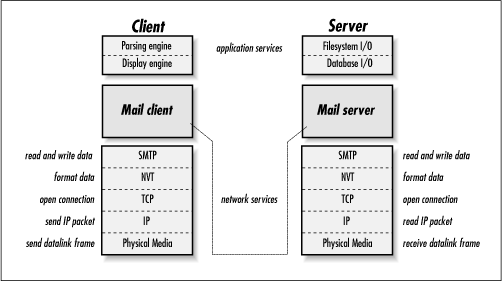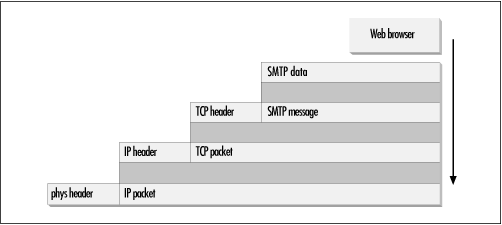TCP/IP Protocols and Services In-Depth
Whenever data is exchanged between two applications across a TCP/IP network, each of the major layers provided by TCP/IP come into play.
This can be seen with email clients that use the Simple Message Transfer Protocol (SMTP) to send mail to a local server, as is shown in Figure 1.5. The email software on the client contains local application-specific code for parsing and displaying email messages, but everything else is done with network protocols such as SMTP, TCP, and IP.
As data is passed through each of the different layers, packets are generated that contain two distinct elements: headers and data. As information is passed down through the protocol stack, each layer encapsulates the previous layer’s information (including both the header and the data) into a new packet, containing a new layer-specific header and the newly minted data segment. This process is shown in Figure 1.6.
At the bottom-most layer, the physical network is used to transfer bits of data (called “frames”) between two devices on the network. IP packets are contained within these network-specific frames. The only reason IP is used for this process is because the data can go over a variety of different network topologies, and as such the TCP/IP applications must have a way of addressing and routing traffic consistently, regardless of the specific networks in use.
Embedded within the IP datagrams are TCP segments, which provide a reliable virtual circuit for the SMTP application protocol to use. TCP does things like open a connection between two application protocol end-points, resend lost data, remove duplicates, and exert flow control, each of which is beyond the simple delivery function of IP itself, yet is common enough to be useful as a separate, distinct service.
The SMTP application protocol contains application-specific semantics. In this case, this might consist of an SMTP command such as “RCPT TO ehall” and an application-specific response code such as 250 (“okay”). Note that the commands and data used by SMTP conform to the NVT specification, which prescribes how the data should be formatted, the types of data allowed, and so forth, although SMTP is doing all of the real work.
As can be seen, each of the layers in the TCP/IP suite provide specific functionality to the layers above and below it, making the overall design extremely modular. It is this modularity that makes TCP/IP so powerful, and also what makes it so complex.
Get Internet Core Protocols: The Definitive Guide now with the O’Reilly learning platform.
O’Reilly members experience books, live events, courses curated by job role, and more from O’Reilly and nearly 200 top publishers.



